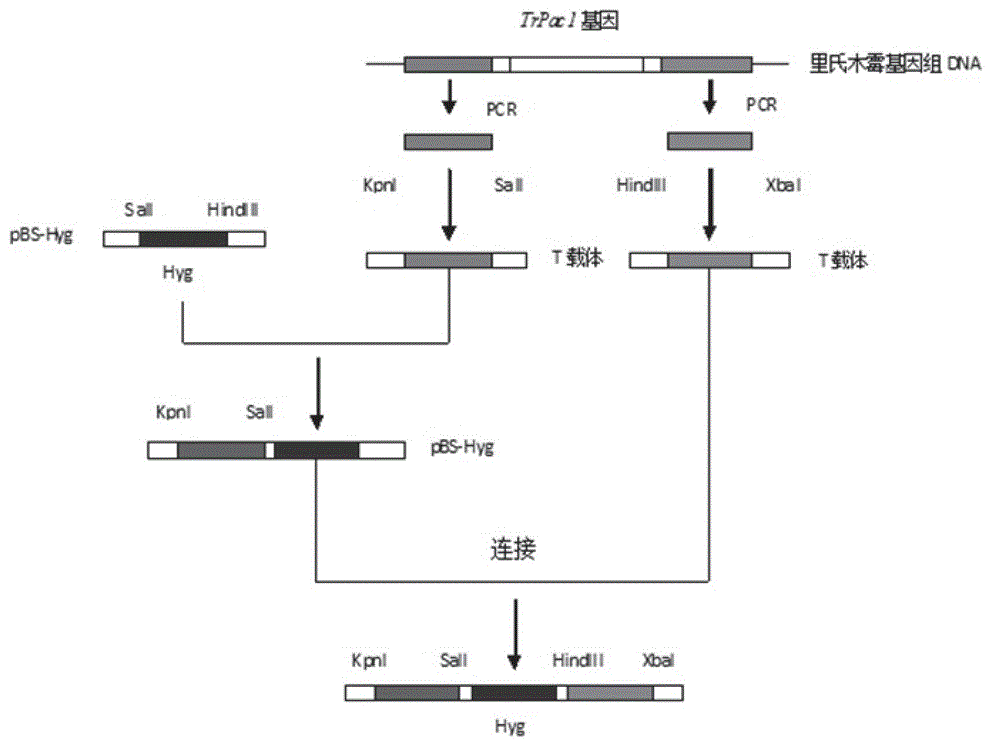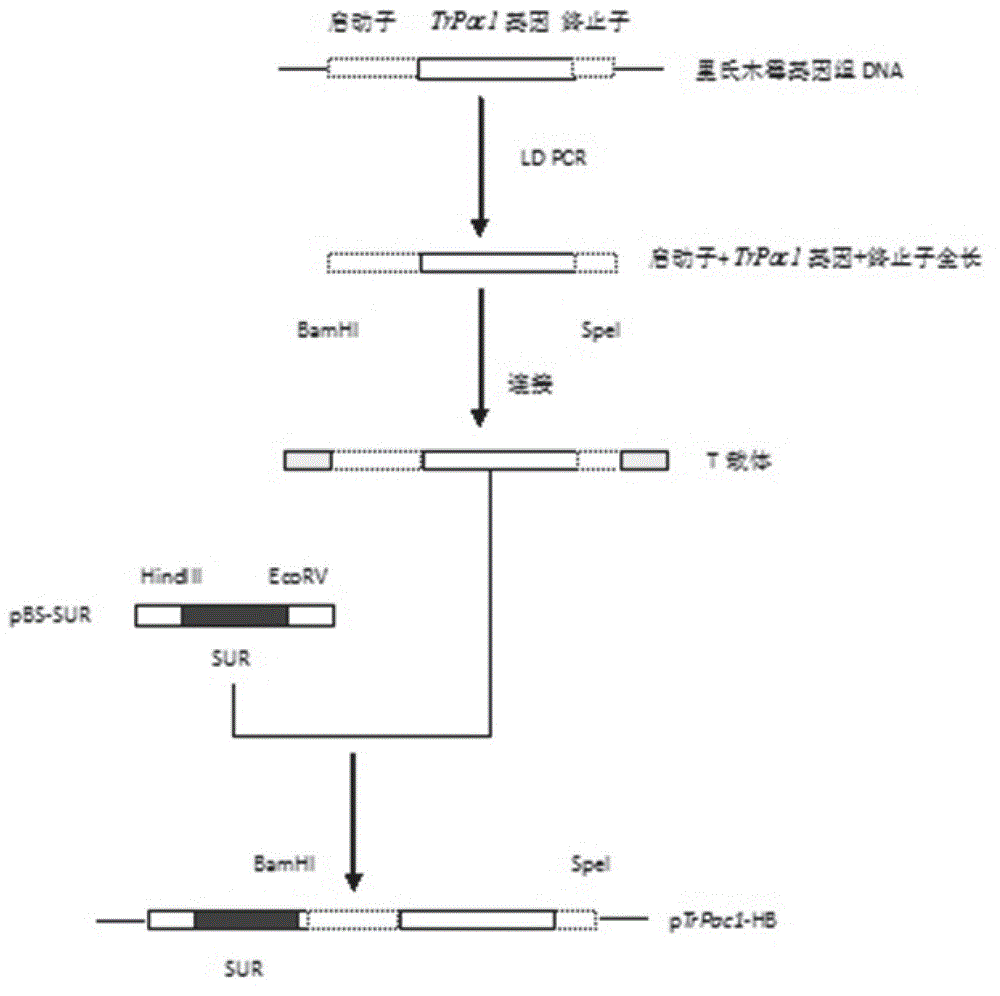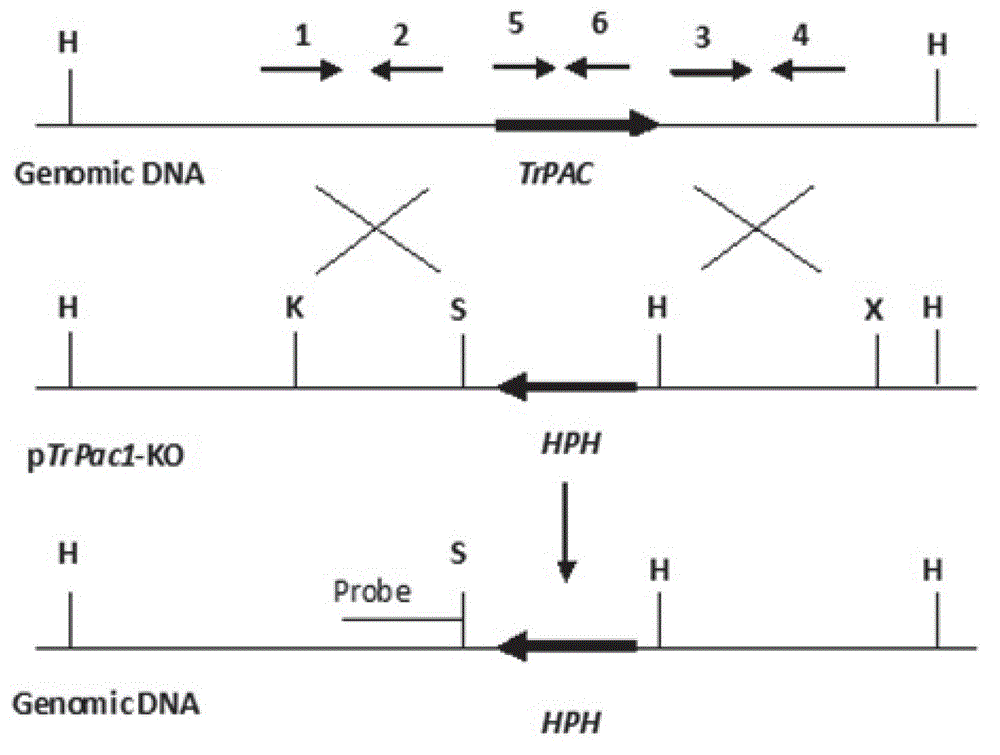Transcriptional regulation factor derived from trichoderma reesei and coding gene and application of transcriptional regulation factor
A transcriptional regulator, Trichoderma reesei technology, applied in applications, genetic engineering, plant genetic improvement, etc.
- Summary
- Abstract
- Description
- Claims
- Application Information
AI Technical Summary
Problems solved by technology
Method used
Image
Examples
Embodiment 1
[0048] Example 1: Full gene cloning of the transcriptional regulator TrPac1 in Trichoderma reesei
[0049] 1. Cloning of TrPac1 gene DNA sequence
[0050] Genomic DNA was extracted from Trichoderma reesei strain QM9414 (preserved in the inventor's laboratory) as a template, and then primers were designed according to the information in the Trichoderma reesei genome database, and the target fragment was obtained by high-fidelity PCR.
[0051] (1) Extraction of Trichoderma reesei genomic DNA
[0052] Wash the Trichoderma reesei spores growing on the PDA plate with sterile water, and filter with sterile three-layer lens cleaning paper after washing, and dilute to 10 6 Pieces / ml; 1ml of spore suspension was inoculated into an Erlenmeyer flask containing 80ml of CM medium, and cultured at 28°C and 180rpm for 24h. The cultured hyphae were filtered with sterilized three-layer lens cleaning paper, and the hyphae were washed 2-3 times with distilled water, then collected, blotted dry with abso...
Embodiment 2
[0062] Example 2: Cloning of the cDNA sequence of the transcriptional regulator TrPac1 gene from Trichoderma reesei
[0063] 1. Extraction of total RNA from Trichoderma reesei
[0064] Wash the Trichoderma reesei spores growing on the PDA plate with sterile water, and filter with sterile three-layer lens cleaning paper after washing, and dilute to 10 6 Pieces / ml; 1ml of spore suspension was inoculated into an Erlenmeyer flask containing 80ml of CM medium, and cultured at 28°C and 180rpm for 24h. The cultured hyphae are filtered with sterile three-layer lens cleaning paper, and the hyphae are washed 2-3 times with distilled water, and then collected, dried with absorbent paper, and the collected hyphae are extracted immediately with RNA extraction kit or first It was frozen in liquid nitrogen and then stored at -80°C for subsequent extraction. RNA extracted samples were immediately reverse transcribed to obtain single-stranded cDNA.
[0065] The reverse transcription product is used...
Embodiment 3
[0072] Example 3: Construction of TrPac1 gene knockout vector
[0073] A three-stage method was used to construct a gene knockout vector, that is, the upstream and downstream sequences of the TrPac1 gene with a length of 1000bp-2000bp were inserted into the two ends of the hygromycin resistance gene.
[0074] Firstly, the upstream and downstream fragments of TrPac1 gene were amplified separately from the Trichoderma reesei genome. Each fragment was about 1000 bp in length. The pGEM-T vector was connected to the upstream and the KpnI and SalI restriction enzymes were used for the upstream and downstream. HidIII and XbaI restriction endonuclease double restriction enzyme cut sites, after cutting from the T vector, first connect the upstream fragment to pBS-Hyr with the same restriction enzyme cut site, and then use HidIII and XbaI to cut the above vector. Connect the downstream fragment after digestion of the T vector to the restriction site to construct the gene knockout vector.
[...
PUM
 Login to View More
Login to View More Abstract
Description
Claims
Application Information
 Login to View More
Login to View More - R&D Engineer
- R&D Manager
- IP Professional
- Industry Leading Data Capabilities
- Powerful AI technology
- Patent DNA Extraction
Browse by: Latest US Patents, China's latest patents, Technical Efficacy Thesaurus, Application Domain, Technology Topic, Popular Technical Reports.
© 2024 PatSnap. All rights reserved.Legal|Privacy policy|Modern Slavery Act Transparency Statement|Sitemap|About US| Contact US: help@patsnap.com










